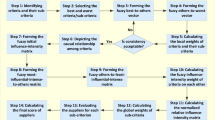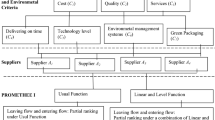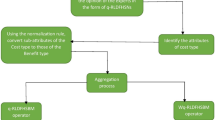Abstract
In spite of the increasing awareness apparent in the previous studies regarding the evaluation suppliers considering sustainability aspects, there are limitations on the incorporation of sustainable performance in terms of traditional, green and social aspects in supplier selection and order allocation. This paper presents the development of an integrated fuzzy TOPSIS-possibilistic multi objectives model to (1) solve a two-stage sustainable supplier selection problem; and (2) allocate the optimal flow of products quantity that should be ordered from suppliers towards the minimization of expected costs, environmental impact and travel time and maximization of social impact. Suppliers’ sustainable performance was based on traditional, green and social criteria, and quantified by using fuzzy TOPSIS and then integrated into the possibilistic multi objective model. The latter helps decision makers in having an order allocation plan that considers sustainability aspect. Furthermore, the multi-objective optimization model was re-developed as a possibilistic multi-objective optimization model (PMOOM) to handle the dynamic nature in some of the input data. Next, the LP-metrics method was employed to derive Pareto solutions out of the PMOOM. The quality of the obtained Pareto solutions was evaluated using the global criterion approach aiming to help decision makers in selecting the final Pareto solution. The applicability of the developed integrated fuzzy TOPSIS-possibilistic multi-objective approach was proven with sensitivity analysis on a case study of a meat supply chain.


Similar content being viewed by others
References
Abdollahzadeh, H., & Atashgar, K. (2017). Optimal design of a multi-state system with uncertainty in supplier selection. Computers & Industrial Engineering, 105, 411–424.
Accorsi, R., Cholette, S., Manzini, M., Pini, C., & Penazzi, S. (2016). The land-network problem: Ecosystem carbon balance in planning sustainable agro-food supply chains. Journal of Cleaner Production, 112, 158–171.
Ageron, B., Gunasekaran, A., & Spalanzani, A. (2012). Sustainable supply management: An empirical study. International Journal of Production Economics, 140(1), 168–182.
Akman, G. (2015). Evaluating suppliers to include green supplier development programs via fuzzy c-means and VIKOR methods. Computers & Industrial Engineering, 86, 69–82.
Al-e-hashem, M. S. M. J., Malekly, H., & Aryanezhad, M. B. (2011). A multi-objective robust optimization model for multi-product multi-site aggregate production planning in a supply chain under uncertainty. International Journal of Production Economics, 134, 28–42.
Amindoust, A., Ahmed, S., Saghafinia, A., & Bahreininejad, A. (2012). Sustainable supplier selection: A ranking model based on fuzzy inference system. Applied Soft Computing, 12(6), 1668–1677.
Amorim, P., et al. (2016). Supplier selection in the processed food industry under uncertainty. European Journal of Operational Research, 252(3), 801–814.
Anisul Huq, F., Stevenson, M., & Zorzini, M. (2014). Social sustainability in developing country suppliers: An exploratory study in the readymade garments industry of Bangladesh. International Journal of Operations Production Management, 34(5), 610–638.
Apaiaha, R. K., Linnemanna, A. R., & Van der Kooi, H. J. (2006). Exergy analysis: A tool to study the sustainability of food supply chains. Food Research International, 39(1), 1–11.
Araújo, M. C. B., Alencar, L. H., & Mota, C. M. M. (2017). Project procurement management: A structured literature review. International Journal of Project Management, 35(3), 353–377.
Awasthi, A., Chauhan, S. S., & Goyal, S. K. (2010). A fuzzy multi criteria approach for evaluating environmental performance of suppliers. International Journal of Production Economics, 126, 370–378.
Ayhan, M. B., & Kilic, H. S. (2015). A two stage approach for supplier selection problem in multi-item/multi-supplier environment with quantity discounts. Computers & Industrial Engineering, 85, 1–12.
Azadeh, A., Raoofi, Z., & Zarrin, M. (2016). A multi-objective fuzzy linear programming model for optimization of natural gas supply chain through a greenhouse gas reduction approach. Journal of Natural Gas Science and Engineering, 26, 702–710.
Azadi, M., Jafarian, M., Saen, R. F., & Mirhedayatian, S. M. (2015). A new fuzzy DEA model for evaluation of efficiency and effectiveness of suppliers in sustainable supply chain management context. Computers & Operations Research, 54, 274–285.
Azadnia, A. H., Saman, M. Z. M., Wong, K. Y., Ghadimi, P., & Zakuan, N. (2012). Sustainable supplier selection based on selforganizing map neural network and multi criteria decision making approaches. Procedia—Social and Behavioral Sciences, 65, 879–884.
Bai, C., & Sarkis, J. (2010). Integrating sustainability into supplier selection with grey system and rough set methodologies. International Journal of Production Economics, 124(1), 252–264.
Banaeian, N., Mobli, H., Nielsen, I. E., & Omid, M. (2015). A methodology for green supplier selection in food industries (pp. 3–23)., Technology management for sustainable production and logistics part of the series eco production Berlin: Springer.
Banaeian, N., et al. (2017). Green supplier selection using fuzzy group decision making methods: A case study from the agri-food industry. Computers and Operations Research, 89, 337–347.
Behzadian, M., Otaghsara, S. K., Yazdani, M., & Ignatius, J. (2012). A state-of the-art survey of TOPSIS applications, Expert Systems with Applications, 39, 13051–13069.
Boran, F. E., Genç, S., Kurt, M., & Akay, D. (2009). A multi-criteria intuitionistic fuzzy group decision making for supplier selection with TOPSIS method. Expert Systems with Applications, 36(8), 11363–11368.
Bottani, E., & Rizzi, A. (2005). A fuzzy multi-attribute framework for supplier selection in an e-procurement environment. International Journal of Logistics Research and Applications, 8(3), 249–266.
Brandenburg, M., Govindan, K., Sarkis, J., & Seuring, S. (2014). Quantitative models for sustainable supply chain management: Developments and directions. European Journal of Operational Research, 233(2), 299–312.
Büyüközkan, G., & Çapan, A. (2007). Improving green supply chain management practices: A case study. In: International logistic and supply chain management congress (Vol. 8–9, pp. 597–605).
Çevikcan, E., Çebi, S., & Kaya, I. (2009). Fuzzy VIKOR and fuzzy axiomatic design versus to fuzzy TOPSIS: An application of candidate assessment. Multiple Valued Logic and Soft Computing, 15(2–3), 181–208.
Chen, C. T. (2000). Extensions of the TOPSIS for group decision-making under fuzzy environment. Fuzzy Sets and Systems, 114(1), 1–9.
Claudia, N., Lasch, R., & Kellner, R. (2016). Integrating sustainability into strategic supplier portfolio selection. Management Decision, 54(1), 194–221.
Coello, C. A. C., Lamont, G. B., & Veldhuisen, D. A. V. (2007). Evolutionary algorithms for solving multi- objective problems. Berlin: Springer.
Dai, J., & Blackhurst, J. (2011). A four-phase AHP–QFD approach for supplier assessment: A sustainability perspective. International Journal of Production Research, 50(19), 5474–5490.
Darbari, J. D., Kannan, D., Agarwal, V., et al. (2017). Fuzzy criteria programming approach for optimising the TBL performance of closed loop supply chain network design problem. Annals of Operations Research. https://doi.org/10.1007/s10479-017-2701-2.
Davis, T. (1993). Effective supply chain management. Sloan Management Review, 34, 35–46.
Dukyil, A., Mohammed A., & Darweesh M. (2017). A cost-effective decision making algorithm for an RFID-enabled passport tracking system: A fuzzy multi-objective approach. In IEEE computing conference, London, UK (pp. 88–95).
Dukyil, A., Mohammed, A., & Darweesh, M. (2018). Design and optimization of an RFID-enabled passport tracking system. Computation Design and Engineering, 5, 94–103.
EU. (2002). Regulation (EC) no 178/2002 of the European parliament and of the council of 28 January 2002. The Official Journal of the European Union, L31, 1–24.
Fallahpour, A., & Moghassem, A. (2012). Evaluating applicability of VIKOR method of multi-criteria decision making for parameters selection problem in rotor spinning. Fibers Polym, 13, 802–808
Fallahpour, A., Olugu, E. U., Musa, S. N., Wong, K. Y., & Noori, S. (2017). A decision support model for sustainable supplier selection in sustainable supply chain management. Computers & Industrial Engineering, 105, 391–410.
Fattahi, M., Mahootchi, M., & Govindan, K. (2015). Dynamic supply chain network design with capacity planning and multi-period pricing. Transportation Research Part E: Logistics and Transportation Review, 81, 169–202.
Gaziulusoy, A. I. (2015). A critical review of approaches available for design and innovation teams through the perspective of sustainability science and system innovation theories. Journal of Cleaner Production, 107, 366–377.
Gholamiana, N., Mahdavia, I., Tavakkoli-Moghaddamb, R., & Mahdavi-Amiric, N. (2015). Comprehensive fuzzy multi-objective multi-product multi-site aggregate production planning decisions in a supply chain under uncertainty. Applied Soft Computing, 37, 585–607.
Govindan, K., Kadziński, M., & Sivakumar, R. (2017). Application of a novel PROMETHEE-based method for construction of a group compromise ranking to prioritization of green suppliers in food supply chain. Omega, 71, 129–145.
Govindan, K., Khodaverdi, R., & Jafarian, A. (2013). A Fuzzy Multi criteria approach for measuring sustainability performance of a supplier based on triple bottom line approach. Journal of Cleaner Production, 47, 345–354.
Govindan, K., Paam, P., & Abtahi, A.-R. (2016). A fuzzy multi-objective optimization model for sustainable reverse logistics network design. Ecological Indicators, 67, 753–768.
Govindan, K., Rajendran, S., Sarkis, J., & Murugesan, P. (2015). Multi criteria decision making approaches for green supplier evaluation and selection: A literature review. Journal of Cleaner Production, 98, 66–83.
Govindan, K., & Sivakumar, R. (2016). Green supplier selection and order allocation in a low-carbon paper industry: Integrated multi-criteria heterogeneous decision making and multi-objective linear programming approaches. Annals of Operations Research, 238, 243–276.
Grimm, J. H., Hofstetter, J. S., & Sarkis, J. (2014). Critical factors for sub-supplier management: A sustainable food supply chains perspective. Journal of Cleaner Production, 152, 159–173.
Hashemian, S. M., Behzadian, M., Samizadeh, R., & Ignatius, J. (2014). A fuzzy hybrid group decision support system approach for the supplier evaluation process. International Journal of Advanced Manufacturing Technology, 73(5–8), 1105–1117.
HMC, UK. (2010). http://www.halalhmc.org/, Available: http://www.halalhmc.org/test-demo.htm. Accessed October 26, 2016.
Hsu, C. W., Kuo, T. C., Chen, S. H., & Hu, A. H. (2013). Using DEMATEL to develop a carbon management model of supplier selection in green supply chain management. Journal of Cleaner Production, 56, 164–172.
Hwang, C. L., & Yoon, K. (1981). Multiple attribute decision making: Methods and applications. New York: Springer.
Jiménez López, M., Arenas, M., Bilbao, A., & Rodriguez, M. V. (2007). Linear programming with fuzzy parameters: An interactive method resolution. European Journal of Operational Research, 177(3), 1599–1609.
Junior, F. R. L., Osiro, L., & Carpinetti, L. C. R. (2014). A comparison between Fuzzy AHP and Fuzzy TOPSIS methods to supplier selection. Applied Soft Computing, 21, 194–209.
Kannan, D., Govindan, K., & Rajendran, S. (2015). Fuzzy axiomatic design approach based green supplier selection: A case study from singapore. Journal of Cleaner Production, 96, 194–208.
Klibi, W., Martel, A., & Guitouni, A. (2010). The design of robust value-creating supply chain networks: A critical review. European Journal of Operational Research, 203(2), 283–293.
Lau, H. C. W., Wong, C. W. Y., Lau, P. K. H., Pun, K. F., Chin, K. S., & Jiang, B. (2003). A fuzzy multi- criteria decision support procedure for enhancing information delivery in extended enterprise networks. Engineering Applications with Artificial Intelligent, 16, 1–9.
Lee, M. S., Jin, S. R., Donghyun, C., & Yonghwi, N. (2013). Pressures affecting green supply chain performance. Management Decision, 51(8), 1753–1768.
Luthra, S., Govindan, K., Kannan, D., Mangla, S. K., & Garg, C. P. (2017). An integrated framework for sustainable supplier selection and evaluation in supply chains. Journal of Cleaner Production, 140, 1686–1698.
Magdalena, R. (2012). Supplier selection for food industry: A combination of taguchi loss function and fuzzy analytical hierarchy process. In The 3rd international conference on technology and operations management, Bandung, Indonesia.
Mahdiloo, M., Saen, R. F., & Lee, K. H. (2015). Technical, environmental and ecoefficiency measurement for supplier selection: An extension and application of data envelopment analysis. International Journal of Production Economics, 168, 279–289.
Maloni, M. J., & Brown, M. E. (2006). Corporate social responsibility in the supply chain: An application in the food industry. Journal of Business Ethics, 68(1), 35–52.
Matos, S., & Hall, J. (2007). Integrating sustainable development in the supply chain: The case of life cycle assessment in oil and gas and agricultural biotechnology. Journal of Operations Management, 25(6), 1083–1102.
Mehrbod, M., Tu, N., Miao, L., et al. (2012). Interactive fuzzy goal programming for a multi-objective closed-loop logistics network. Annals of Operations Research, 201, 367–381.
Mohammed, A., Harris, I., & Dukyil, A. (2018a). A trasilient decision making tool for vendor selection: A hybrid-MCDM algorithm. Management Decision. https://doi.org/10.1108/MD-04-2018-0478.
Mohammed, A., Harris, I., Soroka, A., Mohamed, N., & Ramjaun, T. (2018b). Evaluating green and resilient supplier performance: AHP-Fuzzy TOPSIS decision-making approach. In Proceedings of the 7th international conference on operations research and enterprise systems (ICORES 2018) (pp. 209–216).
Mohammed, A., Harris, I., Soroka, A., & Nujoom, R. (2018b). A hybrid MCDM-fuzzy multi-objective programming approach for a G-Resilient supply chain network design. Computers & Industrial Engineering. https://doi.org/10.1016/j.cie.2018.09.052. (in press).
Mohammed, A. & Wang, Q. (2015). Integrity of an RFID-enabled HMSC network. In Proceedings of the third international conference on digital enterprise and information systems, China (pp. 79–86).
Mohammed, A., & Wang, Q. (2017). The fuzzy multi-objective distribution planner for a green meat supply chain. International Journal of Production Economics, 184, 47–58.
Mohammed, A., Wang, Q., Alyahya, S., & Binnette, N. (2017a). Design and optimization of an RFID-enabled automated warehousing system under uncertainties: A multi-criterion fuzzy programming approach. The International Journal of Advanced Manufacturing Technology, 91(5), 1661–1670.
Mohammed, A., Wang, Q., & Li, X. (2017b). A study in integrity of an RFID-monitoring HMSC. International Journal of Food Properties, 20, 1145–1158.
Nielsen, I. E., Banaeian, N., Golinska, P., Mobli, H., & Omid, M. (2014). Green supplier selection criteria: From a litreture review to a flexible framework for determination of suitable criteria. In P. Golinska (Ed.), Eco production book series: Logistic operations, supply chain management and sustainability (pp. 79–100). Berlin: Springer.
Nujoom, R., Mohammed, A., & Wang, Q. (2018). Optimisation of a sustainable manufacturing system design using the multi-objective approach. The International Journal of Advanced Manufacturing Technology, 96, 2539. https://doi.org/10.1007/s00170-018-1649-y.
Nujoom, R., Mohammed, A., Wang, Q., & Bennett, N. (2017). A sustainable manufacturing system design: A fuzzy multi-objective optimization model. Environmental Science and Pollution Research. https://doi.org/10.1007/s11356-017-9787-6.
Pandu, R. G. (2009). Multi-objective optimization: Techniques and applications in chemical engineering (Advances in process systems engineering). Singapore: World Scientific Publishing.
Qin, Z., & Ji, X. (2010). Logistics network design for product recovery in fuzzy environment. European Journal of Operational Research, 202, 479–490.
Roshandel, J., Miri-Nargesi, S. S., & Hatami-Shirkouhi, L. (2013). Evaluating and selecting the supplier in detergent production industry using hierarchical fuzzy TOPSIS. Applied Mathematical Modelling, 37, 10170–10181.
Roszkowska, E. (2011). Multi-criteria decision making models by applying the topsis method to crisp and interval data. Multiple Criteria Decision Making, 6, 200–230.
Ruiz-Femenia, R., Guillen-Gosalbez, G., Jimenez, L., & Caballero, J. A. (2013). Multi-objective optimization of environmentally conscious chemical supply chains under demand uncertainty. Chemical Engineering Science, 95, 1–11.
Saaty, T. L. (2000). Fundamentals of decision making and priority theory with the analytic hierarchy process (Vol. 6). Pittsburgh: RWS Publications.
Santibañez-Aguilar, J. E., Morales-Rodriguez, R., González-Campos, R. J., & Ponce-Ortega, J. M. (2016). Stochastic design of biorefinery supply chains considering economic and environmental objectives. Journal of Cleaner Production, 136(B), 224–245.
Sarkis, J. (1999). How green is the supply chain? Practice and research. Worchester: Graduate School of Management, Clark University.
Shen, L., Olfat, L., Govindan, K., Khodaverdi, R., & Diabat, A. (2013). A fuzzy multi criteria approach for evaluating green supplier’s performance in green supply chain with linguistic preferences. Resources, Conservation and Recycling, 74, 170–179.
Singh, S. K., & Yadav, S. P. (2017). Intuitionistic fuzzy multi-objective linear programming problem with various membership functions. Annals of Operations Research. https://doi.org/10.1007/s10479-017-2551-y.
Stevens, G. C. (1990). Successful supply-chain management. Management Decision, 28, 8.
Su, C. M., Horng, D. J., Tseng, M. L., Chiu, A. S., Wu, K. J., & Chen, H. P. (2016). Improving sustainable supply chain management using a novel hierarchical grey- DEMATEL approach. Journal of Cleaner Production, 134(Part-B), 469–481.
Tavana, M., Khalili-Damghani, K., & Abtahi, A. R. (2013). A fuzzy multidimensional multiple-choice knapsack model for project portfolio selection using an evolutionary algorithm. Annals of Operations Research, 206, 449.
Trapp, A. C., & Sarkis, J. (2016). Identifying robust portfolios of suppliers: A sustainability selection and development perspective. Journal of Cleaner Production, 112, 2088–2100.
Uygun, Ö., & Dede, A. (2016). Performance evaluation of green supply chain management using integrated fuzzy multi-criteria decision making techniques. Computers & Industrial Engineering, 102, 502–511.
Vijayvargiya, A., & Dey, A. K. (2010). An analytical approach for selection of a logistics provider. Management Decision, 48(3), 403–418.
Wang, H.-F., & Hsu, H.-W. (2010). Resolution of an uncertain closed-loop logistics model: An application to fuzzy linear programs with risk analysis. Journal of Environment Management, 91(11), 2148–2162.
Wang, Z., Mathiyazhagan, K., Xu, L., & Diabat, A. (2016). A decision making trial and evaluation laboratory approach to analyze the barriers to green supply chain management adoption in a food packaging company. Journal of Cleaner Production, 117, 19–28.
Weber, C. A., Current, J. R., & Benton, W. C. (1991). Vender selection criteria and methods. European Journal of Operational Research, 50(1), 2–18.
Xia, Y., & Tang, T. L. (2011). Sustainability in supply chain management: Suggestions for the auto industry. Management Decision, 49(4), 495–512.
Xu, L. D. (1988). A fuzzy multiobjective programming algorithm in decision support systems. Annals of Operations Research, 12, 315.
Yazdani, M., Hashemkhani Zolfani, S., & Zavadskas, E. K. (2016). New integration of MCDM methods and QFD in the selection of green suppliers. Journal of Business Economics and Management, 17(6), 1–17.
Acknowledgements
The author acknowledges the financial support from the European Regional Development Fund through the Welsh Government for ASTUTE 2020 (Advanced Sustainable Manufacturing Technologies) to facilitate this work. The author would like to thank the anonymous referees whose thorough reviews and insightful comments made a valuable contribution to this article.
Author information
Authors and Affiliations
Corresponding author
Additional information
Publisher's Note
Springer Nature remains neutral with regard to jurisdictional claims in published maps and institutional affiliations.
Rights and permissions
About this article
Cite this article
Mohammed, A. Towards a sustainable assessment of suppliers: an integrated fuzzy TOPSIS-possibilistic multi-objective approach. Ann Oper Res 293, 639–668 (2020). https://doi.org/10.1007/s10479-019-03167-5
Published:
Issue Date:
DOI: https://doi.org/10.1007/s10479-019-03167-5




